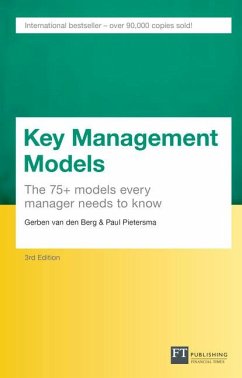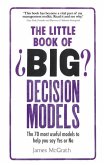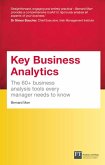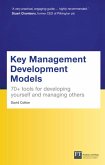22,99 €
inkl. MwSt.
Versandfertig in über 4 Wochen

11 °P sammeln
- Broschiertes Buch
- Merkliste
- Auf die Merkliste
- Bewerten Bewerten
- Teilen
- Produkt teilen
- Produkterinnerung
- Produkterinnerung
This best selling management book is a true classic. If you want to be a model manager, keep this new, even better 3rd edition close at hand. Key Management Models has the winning combination of brevity and clarity, giving you short, practical overviews of the top classic and cutting edge management models in an easy-to-use, ready reference format. Whether you want to remind yourself about models you've already come across, or want to find new ones, you'll find yourself referring back to it again and again. It's the essential guide to all the management models you'll ever need to know about.…mehr
Andere Kunden interessierten sich auch für
![Key MBA Models, Travel Edition Key MBA Models, Travel Edition]() Julian BirkinshawKey MBA Models, Travel Edition22,99 €
Julian BirkinshawKey MBA Models, Travel Edition22,99 €![Stats: Data and Models, Global Edition Stats: Data and Models, Global Edition]() Richard De VeauxStats: Data and Models, Global Edition98,99 €
Richard De VeauxStats: Data and Models, Global Edition98,99 €![Little Book of Big Decision Models, The Little Book of Big Decision Models, The]() James McGrathLittle Book of Big Decision Models, The17,99 €
James McGrathLittle Book of Big Decision Models, The17,99 €![Classroom Management: Models, Applications and Cases Classroom Management: Models, Applications and Cases]() M. ManningClassroom Management: Models, Applications and Cases86,99 €
M. ManningClassroom Management: Models, Applications and Cases86,99 €![Key Business Analytics, Travel Edition Key Business Analytics, Travel Edition]() Bernard MarrKey Business Analytics, Travel Edition22,99 €
Bernard MarrKey Business Analytics, Travel Edition22,99 €![Key Management Development Models (Travel Edition) Key Management Development Models (Travel Edition)]() David CottonKey Management Development Models (Travel Edition)22,99 €
David CottonKey Management Development Models (Travel Edition)22,99 €![Organizational Behavior, Global Edition Organizational Behavior, Global Edition]() Stephen RobbinsOrganizational Behavior, Global Edition77,99 €
Stephen RobbinsOrganizational Behavior, Global Edition77,99 €-
-
-
This best selling management book is a true classic. If you want to be a model manager, keep this new, even better 3rd edition close at hand. Key Management Models has the winning combination of brevity and clarity, giving you short, practical overviews of the top classic and cutting edge management models in an easy-to-use, ready reference format. Whether you want to remind yourself about models you've already come across, or want to find new ones, you'll find yourself referring back to it again and again. It's the essential guide to all the management models you'll ever need to know about. 1. Includes the classic and essential management models from the previous 2 editions. 2. Thoroughly updated to include cutting edge new models. 3. Two-colour illustrations and case studies throughout.
Hinweis: Dieser Artikel kann nur an eine deutsche Lieferadresse ausgeliefert werden.
Hinweis: Dieser Artikel kann nur an eine deutsche Lieferadresse ausgeliefert werden.
Produktdetails
- Produktdetails
- Verlag: Pearson Education Limited
- Seitenzahl: 344
- Erscheinungstermin: 25. Dezember 2015
- Englisch
- Abmessung: 216mm x 136mm x 22mm
- Gewicht: 378g
- ISBN-13: 9781292081762
- ISBN-10: 1292081767
- Artikelnr.: 55277960
- Herstellerkennzeichnung
- Libri GmbH
- Europaallee 1
- 36244 Bad Hersfeld
- gpsr@libri.de
- Verlag: Pearson Education Limited
- Seitenzahl: 344
- Erscheinungstermin: 25. Dezember 2015
- Englisch
- Abmessung: 216mm x 136mm x 22mm
- Gewicht: 378g
- ISBN-13: 9781292081762
- ISBN-10: 1292081767
- Artikelnr.: 55277960
- Herstellerkennzeichnung
- Libri GmbH
- Europaallee 1
- 36244 Bad Hersfeld
- gpsr@libri.de
Marcel van Assen is a senior consultant at the Operations Management group of Berenschot. His industrial consulting experience covers a range of manufacturing, supply chain, and strategic issues, from operational excellence to value-innovation based on strategic conversation, roadmapping and foresight. Marcel is also an assistant professor of manufacturing management at the Department of Management of Technology and Innovation Department of RSM Erasmus University. He has written several books and articles on operations and innovation management. He holds an MSc in mechanical engineering from the University of Twente, an MSc in business administration (strategy and organisation) from the Open University, and a PhD in business administration from RSM Erasmus University. In addition he is associate member of ERIM (Erasmus Research Institute of Management). Gerben van den Berg read business administration at the University of Groningen. He works at Berenschot as consultant in the Business Strategies group. He is a co-author of the book Excellence = optimization and innovation and (co)author of several articles concerning strategic management. Paul Pietersma MSc. BA is a strategy consultant and managing director of Business Strategies at Berenschot. He has more than 10 years of experience in the consultancy business during which time he has advised many CEOs and boards of directors on a variety of strategic issues. He has won the Dutch Professionals Award of Management Consultancy, he has published several articles on strategy and he is the (co)author of two leading Dutch strategy books ‘Het Strategieboek I’ and ‘Het Strategieboek II’.
About the authors
Publisher's acknowledgements
Preface
Using this book
Part 1: Corporate and business strategy
1 Ansoff’s matrix and product market grid
2 BCG-matrix
3 Strategic dialogue
4 BHAG
5 Blue ocean strategy
6 Business model canvas
7 Business scope (Abell)
8 Competitive analysis: Porter's five forces model
9 Core competencies
10 Internationalisation strategy framework
11 Road-mapping
12 Scenario planning
13 Strategy maps
14 SWOT analysis
15 Value-disciplines
Part 2: Organisation and governance
16 7-S Framework
17 Balanced scorecard
18 Benchmarking
19 Organisational growth model (Greiner)
20 Offshoring/outsourcing
21 Organisational configurations (Mintzberg)
22 Overhead value analysis
23 Risk management
24 The value chain
Part 3: Finance
25 Activity-based costing
26 Capital asset pricing model (CAPM)
27 Discounted cash flow (DCF) and net present value (NPV)
28 DuPont scheme
29 Economic value added (EVA) and weighted average cost of capital (WACC)
30 Financial ratio analysis: liquidity, solvency and profitability ratios
31 Investment stages
32 Real options theory
33 Risk-reward analysis
34 Value-based management
Part 4: Marketing and sales
35 4Ps of marketing (Kotler)
36 Branding pentagram
37 Client pyramid (Curry)
38 Crowdsourcing
39 Customer journey mapping
40 MABA analysis
41 Social network analysis
42 Stakeholder management
Part 5: Operations, supply chain management and procurement
43 Business process redesign
44 House of purchasing and supply
45 Kaizen/Gemba
46 Lean thinking/just-in-time
47 Purchasing model (Kraljic)
48 Root cause analysis/Pareto analysis
49 Six sigma
50 The EFQM model
51 Value stream mapping
Part 6: Innovation, technology management and e-business
52 Diffusion model
53 Disruptive innovation
54 Hype cycle
55 Innovation circle
56 Information Technology Infrastructure Library (ITIL®)
57 Stage-Gate model
58 Strategic IT-alignment model
59 The Open Group Architecture Framework (TOGAF®)
Part 7: Human Resources (HR) and change management
60 Change quadrants
61 Compensation model
62 Eight phases of change (Kotter)
63 HR business roles
64 Motivational insights
65 Six thinking hats (De Bono)
66 Socially engineered change
67 Team roles (Belbin)
68 The Deming cycle: plan–do–check–act
Part 8: Leadership and (inter)cultural management
69 Bottom of the pyramid
70 CAGE distance framework
71 Competing values
72 Core quadrants
73 Cultural dimensions (Hofstede)
74 Culture dimensions (Trompenaars)
75 Focus-energy matrix
76 Seven habits of highly effective people (Covey)
77 Situational leadership
Appendix: Model matrix and categorization
Index
Publisher's acknowledgements
Preface
Using this book
Part 1: Corporate and business strategy
1 Ansoff’s matrix and product market grid
2 BCG-matrix
3 Strategic dialogue
4 BHAG
5 Blue ocean strategy
6 Business model canvas
7 Business scope (Abell)
8 Competitive analysis: Porter's five forces model
9 Core competencies
10 Internationalisation strategy framework
11 Road-mapping
12 Scenario planning
13 Strategy maps
14 SWOT analysis
15 Value-disciplines
Part 2: Organisation and governance
16 7-S Framework
17 Balanced scorecard
18 Benchmarking
19 Organisational growth model (Greiner)
20 Offshoring/outsourcing
21 Organisational configurations (Mintzberg)
22 Overhead value analysis
23 Risk management
24 The value chain
Part 3: Finance
25 Activity-based costing
26 Capital asset pricing model (CAPM)
27 Discounted cash flow (DCF) and net present value (NPV)
28 DuPont scheme
29 Economic value added (EVA) and weighted average cost of capital (WACC)
30 Financial ratio analysis: liquidity, solvency and profitability ratios
31 Investment stages
32 Real options theory
33 Risk-reward analysis
34 Value-based management
Part 4: Marketing and sales
35 4Ps of marketing (Kotler)
36 Branding pentagram
37 Client pyramid (Curry)
38 Crowdsourcing
39 Customer journey mapping
40 MABA analysis
41 Social network analysis
42 Stakeholder management
Part 5: Operations, supply chain management and procurement
43 Business process redesign
44 House of purchasing and supply
45 Kaizen/Gemba
46 Lean thinking/just-in-time
47 Purchasing model (Kraljic)
48 Root cause analysis/Pareto analysis
49 Six sigma
50 The EFQM model
51 Value stream mapping
Part 6: Innovation, technology management and e-business
52 Diffusion model
53 Disruptive innovation
54 Hype cycle
55 Innovation circle
56 Information Technology Infrastructure Library (ITIL®)
57 Stage-Gate model
58 Strategic IT-alignment model
59 The Open Group Architecture Framework (TOGAF®)
Part 7: Human Resources (HR) and change management
60 Change quadrants
61 Compensation model
62 Eight phases of change (Kotter)
63 HR business roles
64 Motivational insights
65 Six thinking hats (De Bono)
66 Socially engineered change
67 Team roles (Belbin)
68 The Deming cycle: plan–do–check–act
Part 8: Leadership and (inter)cultural management
69 Bottom of the pyramid
70 CAGE distance framework
71 Competing values
72 Core quadrants
73 Cultural dimensions (Hofstede)
74 Culture dimensions (Trompenaars)
75 Focus-energy matrix
76 Seven habits of highly effective people (Covey)
77 Situational leadership
Appendix: Model matrix and categorization
Index
About the authors
Publisher's acknowledgements
Preface
Using this book
Part 1: Corporate and business strategy
1 Ansoff’s matrix and product market grid
2 BCG-matrix
3 Strategic dialogue
4 BHAG
5 Blue ocean strategy
6 Business model canvas
7 Business scope (Abell)
8 Competitive analysis: Porter's five forces model
9 Core competencies
10 Internationalisation strategy framework
11 Road-mapping
12 Scenario planning
13 Strategy maps
14 SWOT analysis
15 Value-disciplines
Part 2: Organisation and governance
16 7-S Framework
17 Balanced scorecard
18 Benchmarking
19 Organisational growth model (Greiner)
20 Offshoring/outsourcing
21 Organisational configurations (Mintzberg)
22 Overhead value analysis
23 Risk management
24 The value chain
Part 3: Finance
25 Activity-based costing
26 Capital asset pricing model (CAPM)
27 Discounted cash flow (DCF) and net present value (NPV)
28 DuPont scheme
29 Economic value added (EVA) and weighted average cost of capital (WACC)
30 Financial ratio analysis: liquidity, solvency and profitability ratios
31 Investment stages
32 Real options theory
33 Risk-reward analysis
34 Value-based management
Part 4: Marketing and sales
35 4Ps of marketing (Kotler)
36 Branding pentagram
37 Client pyramid (Curry)
38 Crowdsourcing
39 Customer journey mapping
40 MABA analysis
41 Social network analysis
42 Stakeholder management
Part 5: Operations, supply chain management and procurement
43 Business process redesign
44 House of purchasing and supply
45 Kaizen/Gemba
46 Lean thinking/just-in-time
47 Purchasing model (Kraljic)
48 Root cause analysis/Pareto analysis
49 Six sigma
50 The EFQM model
51 Value stream mapping
Part 6: Innovation, technology management and e-business
52 Diffusion model
53 Disruptive innovation
54 Hype cycle
55 Innovation circle
56 Information Technology Infrastructure Library (ITIL®)
57 Stage-Gate model
58 Strategic IT-alignment model
59 The Open Group Architecture Framework (TOGAF®)
Part 7: Human Resources (HR) and change management
60 Change quadrants
61 Compensation model
62 Eight phases of change (Kotter)
63 HR business roles
64 Motivational insights
65 Six thinking hats (De Bono)
66 Socially engineered change
67 Team roles (Belbin)
68 The Deming cycle: plan–do–check–act
Part 8: Leadership and (inter)cultural management
69 Bottom of the pyramid
70 CAGE distance framework
71 Competing values
72 Core quadrants
73 Cultural dimensions (Hofstede)
74 Culture dimensions (Trompenaars)
75 Focus-energy matrix
76 Seven habits of highly effective people (Covey)
77 Situational leadership
Appendix: Model matrix and categorization
Index
Publisher's acknowledgements
Preface
Using this book
Part 1: Corporate and business strategy
1 Ansoff’s matrix and product market grid
2 BCG-matrix
3 Strategic dialogue
4 BHAG
5 Blue ocean strategy
6 Business model canvas
7 Business scope (Abell)
8 Competitive analysis: Porter's five forces model
9 Core competencies
10 Internationalisation strategy framework
11 Road-mapping
12 Scenario planning
13 Strategy maps
14 SWOT analysis
15 Value-disciplines
Part 2: Organisation and governance
16 7-S Framework
17 Balanced scorecard
18 Benchmarking
19 Organisational growth model (Greiner)
20 Offshoring/outsourcing
21 Organisational configurations (Mintzberg)
22 Overhead value analysis
23 Risk management
24 The value chain
Part 3: Finance
25 Activity-based costing
26 Capital asset pricing model (CAPM)
27 Discounted cash flow (DCF) and net present value (NPV)
28 DuPont scheme
29 Economic value added (EVA) and weighted average cost of capital (WACC)
30 Financial ratio analysis: liquidity, solvency and profitability ratios
31 Investment stages
32 Real options theory
33 Risk-reward analysis
34 Value-based management
Part 4: Marketing and sales
35 4Ps of marketing (Kotler)
36 Branding pentagram
37 Client pyramid (Curry)
38 Crowdsourcing
39 Customer journey mapping
40 MABA analysis
41 Social network analysis
42 Stakeholder management
Part 5: Operations, supply chain management and procurement
43 Business process redesign
44 House of purchasing and supply
45 Kaizen/Gemba
46 Lean thinking/just-in-time
47 Purchasing model (Kraljic)
48 Root cause analysis/Pareto analysis
49 Six sigma
50 The EFQM model
51 Value stream mapping
Part 6: Innovation, technology management and e-business
52 Diffusion model
53 Disruptive innovation
54 Hype cycle
55 Innovation circle
56 Information Technology Infrastructure Library (ITIL®)
57 Stage-Gate model
58 Strategic IT-alignment model
59 The Open Group Architecture Framework (TOGAF®)
Part 7: Human Resources (HR) and change management
60 Change quadrants
61 Compensation model
62 Eight phases of change (Kotter)
63 HR business roles
64 Motivational insights
65 Six thinking hats (De Bono)
66 Socially engineered change
67 Team roles (Belbin)
68 The Deming cycle: plan–do–check–act
Part 8: Leadership and (inter)cultural management
69 Bottom of the pyramid
70 CAGE distance framework
71 Competing values
72 Core quadrants
73 Cultural dimensions (Hofstede)
74 Culture dimensions (Trompenaars)
75 Focus-energy matrix
76 Seven habits of highly effective people (Covey)
77 Situational leadership
Appendix: Model matrix and categorization
Index







